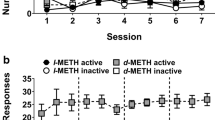Abstract
The development of tolerance, defined as a reduction in pharmacological potency, was studied in various experimental models following repeated administration of neuroleptic drugs to rats, mice and dogs.
Tolerance developed in all models involving stereotyped behaviour induced by central dopaminergic stimulation, whereas no tolerance developed to the cataleptogenic effect and the inhibition of conditioned avoidance reaction. Tolerance development was dependent on pretreatment dose and length of pretreatment period.
Once developed, tolerance persisted for a considerable time, particularly in rats and dogs. Several possible mechanisms by which tolerance could develop are discussed, among which the most likely appears to be 1. increased turnover of dopamine, leading to larger quanta of transmitter being released by the indirect sympathomimetic amine, or 2. increased receptor sensitivity following the prolonged receptor blockade.
Similar content being viewed by others
References
Andén, N.-E., Rubinson, A., Fuxe, K., Hökfelt, T.: Evidence for dopamine receptor Stimulation by apomorphine. J. Pharm. Pharmacol. 19, 627–629 (1967)
Christensen, A. V., MØller Nielsen, I.: Influence of flupenthixol and flupenthixol decanoate on methylphenidate and apomorphine-induced compulsive gnawing in mice. Psychopharmacologia (Berl.) 34, 119–126 (1974)
Finney, D. J.: Probit analysis, 2nd Ed., pp. 65–72. Cambridge University Press 1952
Fjalland, B., MØller Nielsen, I.: Enhancement of methylphenidate-induced stereotypies by repeated administration of neuroleptics. Psychopharmacologia (Berl.) 34, 105–109 (1974)
György, L., Pfeifer, K. A., Hajtman, B.: Modification of certain central nervous effects of haloperidol during long-term treatment in the mouse and rat. Psychopharmacologia (Berl.) 16, 223–233 (1969)
Irwin, S.: Differential tolerance development to the avoidance and locomotor suppressant actions of perphenazine and chlorpromazine. Pharmacologist 3, 75 (1961)
Iwamoto, T., Matsuki, K.: Change of pharmacological effects by repeated administration of some tranquillizers. 1. Sympos. on Drug Metabolism and Action, Nov. 14 to 15 1969 in Chiba, Japan
Julou, L., Bardone, M.-C., Ducrot, R., Laffargue, B., Loiseau, G.: Comparison des effets des neuroleptiques dans divers tests, en administration unique et en administrations répétées. Hypothèses sur la signification des tests utilisés et leur valeur prévisionelle. Neuro-Psycho-Pharmacology (Edit. H. Brill), pp. 293–303. Amsterdam: Excerpta Medica Foundation 1967
Lemberger, L., Witt, E. D., Davis, J. M., Kopin, I. J.: The effects of haloperidol and chlorpromazine on amphetamine metabolism and amphetamine stereotype behavior in the rat. J. Pharmacol. exp. Ther. 174, 428–433 (1970)
MØller Nielsen, I., Fjalland, B., Pedersen, V., Nymark, M.: Development of tolerance in animals by repeated administration of neuroleptics. Psychopharmacologia (Berl.) 26, 100, Suppl. (1972)
MØller Nielsen, I., Pedersen, V., Nymark, M., Franck, K. F., Boeck, V., Fjalland, B. Christensen, A. V.: The comparative pharmacology of flupenthixol and some reference neuroleptics. Acta pharmacol. (Kbh.) (in press) (1973)
Nymark, M.: Apomorphine provoked stereotypy in the dog. Psychopharmacologia (Berl.) 26, 361–368 (1972)
Pedersen, V.: Potentiation of apomorphine effect (compulsive gnawing behaviour) in mice. Acta pharmacol. (Kbh.) 25, Suppl 4, 63 (1967)
Pedersen, V., Christensen, A. V.: Antagonism of methylphenidate-induced stereotyped gnawing in mice. Acta pharmacol. (Kbh.) 31, 488–496 (1972)
Schelkunov, E. L.: Adrenergic effect of chronic administration of neuroleptics. Nature (Lond.) 214, 1210–1212 (1967)
Theobald, W., Büch, O., Delini-Stula, A., Eigenmann, E., Levin, Ph.: Pharmakologische Untersuchungen zur Wirkung von Neuroleptica am Tier nach einmaliger und wiederholter Applikation. Arzneimittel-Forsch. 18, 1491–1495 (1968)
Ther, L., Schramm, H.: Apomorphin-synergismus (Zwangsnagen bei MÄusen) als Test zur Differenzierung psychotroper Substanzen. Arch. int. Pharmacodyn. 138, 302–310 (1962)
Author information
Authors and Affiliations
Rights and permissions
About this article
Cite this article
Nielsen, I.M., Fjalland, B., Pedersen, V. et al. Pharmacology of neuroleptics upon repeated administration. Psychopharmacologia 34, 95–104 (1974). https://doi.org/10.1007/BF00421933
Received:
Revised:
Issue Date:
DOI: https://doi.org/10.1007/BF00421933




